Main menu
Common skin conditions

NEWS
Join DermNet PRO
Read more
Quick links
Retiform purpura — extra information
Retiform purpura
Author: Dr Leah Jones, Medical Registrar, Christchurch District Health Board, Christchurch, New Zealand. Copy edited by Gus Mitchell. November 2020.
Introduction Demographics Causes Clinical features Variation in skin types Complications Diagnosis Differential diagnoses Treatment Outcome
What is retiform purpura?
Retiform purpura is a branching, non-blanching patch or plaque often with skin necrosis and ulceration due to skin ischaemia.
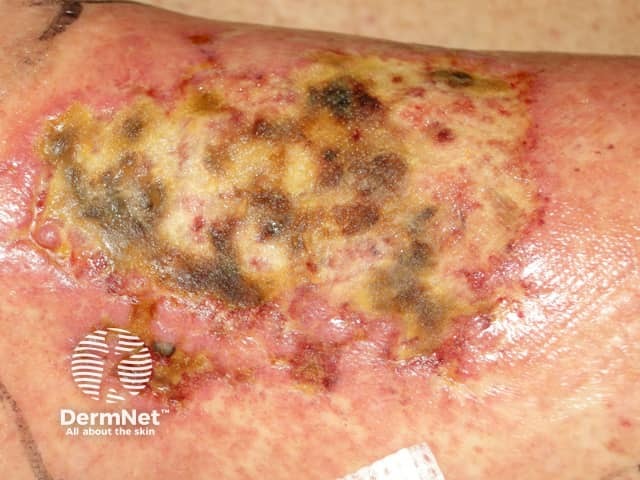
Cryoglobulinaemia

Small vessel vasculitis
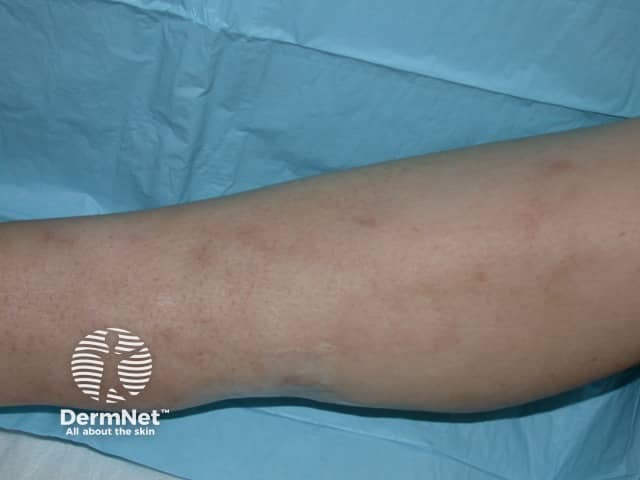
Polyarteritis nodosa
Who gets retiform purpura?
The demographic group affected depends on the underlying diagnosis. Adults and children can present with retiform purpura.
What causes retiform purpura?
Retiform purpura results from either blood vessel wall damage or occlusion of the vessel lumen causing complete vessel obstruction and skin ischaemia downstream.
Vessel wall damage
- Vasculitis of small to medium sized arteries, including polyarteritis nodosa, Henoch-Schönlein purpura, levamisole-induced vasculitis, and other drug-induced vasculitis.
- Deposits in vessel walls, including calciphylaxis and oxalosis.
- Angioinvasive microorganisms includes ecthyma gangrenosum, meningococcal disease, strongyloidiasis, and leprosy.
Retiform purpura due to calciphylaxis
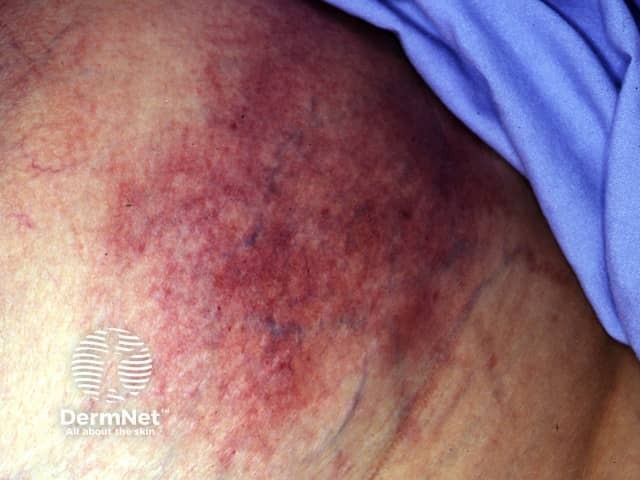


Vessel lumen occlusion
- Hypercoagulable state, including antiphospholipid syndrome, disseminated intravascular coagulation (DIC), thrombotic thrombocytopenic purpura (TTP), haemolytic uraemic syndrome (HUS), and heparin-induced thrombocytopenia.
- Raised or dysfunctional red or white blood cells, including polycythaemia rubra vera, sickle cell anaemia, and intravascular lymphoma.
- Embolic disease, including septic embolus and cholesterol emboli.
- Temperature-related conditions, including cryoglobulinaemia and cryofibrinogenaemia.
Retiform purpura have been reported in seriously ill COVID-19 patients due to microthrombi.
Retiform purpura due to vessel lumen occlusion
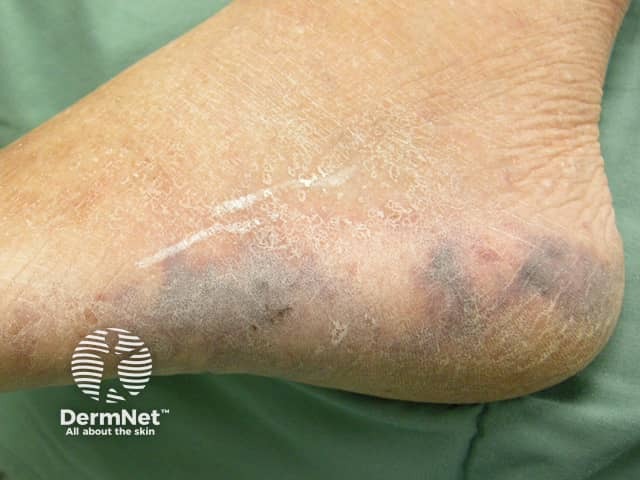
Cryoglobulinaemia

Cholesterol emboli
What are the clinical features of retiform purpura?
Retiform purpura presents as painful dark red or purple patches or plaques with peripheral branching and central purpura, necrosis, and/or ulceration. They can vary in size from small (1–2 cm) to large (>10 cm), may be single or multiple, localised or disseminated. The branching, which is not the same as the netlike pattern of livedo, may only be seen at the edge of one or two lesions but is still the clue to this diagnosis and a potentially serious underlying condition.
Clinical clues to the underlying cause may include the following.
- Patient factors — personal and family history, new medications, recent procedures, immune status, fever, septic shock.
- Age of lesions — sudden onset of many lesions of the same age indicates an acute process; mixed old and new lesions is a chronic low-grade process.
- Lesion morphology — inflammatory retiform purpura consist of a wide erythematous zone around a small central area of impending necrosis. This morphology suggests an underlying infection or vasculitis. Non-inflammatory retiform purpura has a narrow red rim around a large area of central or impending necrosis, suggesting vessel lumen occlusion is the cause.
- Lesion distribution, such as:
- Periumbilical — disseminated strongyloides infection
- Ear rim or lobe — levamisole-induced purpura
- Head and neck — angioinvasive fungal infection
- Distal extremities of hands and feet — embolic or cold-related
- Unilateral — embolic
- Lower limbs — vasculitis
- Fatty areas of abdomen or thighs — warfarin-induced skin necrosis or heparin necrosis.
Retiform purpura of the lower limbs due to vessel wall damage
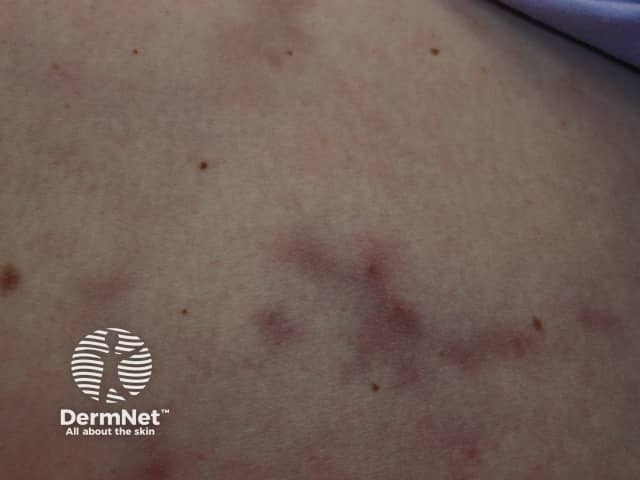
Polyarteritis nodosa
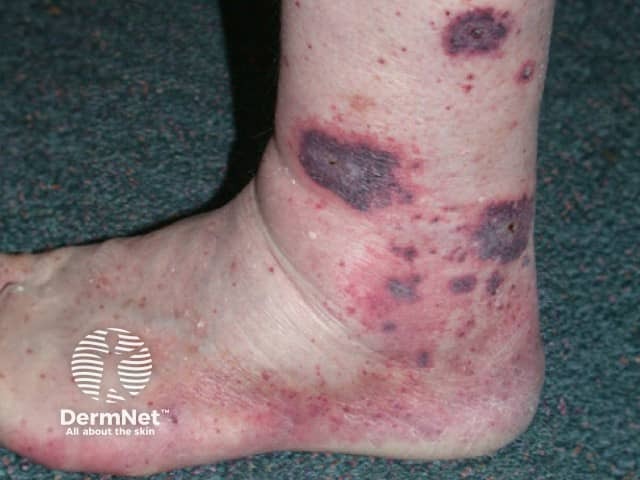
Small vessel vasculitis
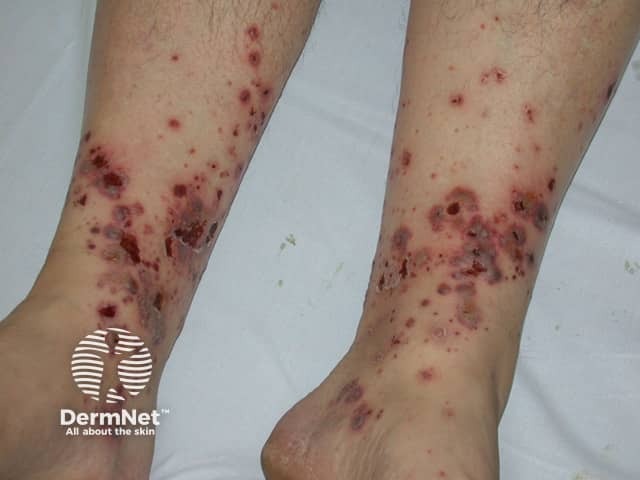
Vasculitis
How do clinical features vary in differing types of skin?
Retiform purpura is not well described in darker skin types. However, case reports note the purpura to be a dark purple colour, rather than the bright red that may be observed in lighter skin types.
What are the complications of retiform purpura?
Retiform purpura can be complicated by:
- Pain requiring opioid analgesics
- Secondary infection of ulceration
- Circulatory collapse if widespread.
Complications depend on the underlying cause.
How is retiform purpura diagnosed?
Retiform purpura is a clinical diagnosis based on the typical appearance. Investigations are required to determine the underlying cause and will be guided by:
- Clinical assessment and the patient's condition
- Chronicity of the lesions
- Suspected cause based on history and examination.
Routine tests will include:
- Full blood count
- Liver function tests
- Urea, creatinine, and electrolytes
- Urinalysis.
A skin biopsy taken from the peripheral purpuric rim should be performed; the histology varies with the underlying diagnosis. Examples include warfarin necrosis pathology, calciphylaxis pathology, and cholesterol emboli pathology.
What is the differential diagnosis for retiform purpura?
The differential diagnosis of retiform purpura includes:
- Livedo reticularis — is due to transient, incomplete ischaemia and presents with complete discoloured rings that typically come and go
- Livedo racemosa — is seen with more significant ischaemia than livedo reticularis, showing broken rings of discolouration and, unlike retiform purpura, necrosis and ulceration is uncommon.
- Pressure-induced necrosis or unstageable pressure injury — shows central necrosis without the associated branching purpura.
What is the treatment for retiform purpura?
General measures
Ulcerated skin lesions may require appropriate wound dressings and debridement of necrotic tissue. Circulatory support and blood product replacement may be necessary.
Specific measures
Treatment of retiform purpura is the specific treatment of the underlying cause.
What is the outcome for retiform purpura?
The outcome depends on the underlying diagnosis of the retiform purpura, ranging from removable precipitants such as emboli secondary to a procedure with full recovery expected, through to life-threatening situations as in a disseminated opportunistic infection.
Bibliography
- Georgesen C, Fox LP, Harp J. Retiform purpura: a diagnostic approach. J Am Acad Dermatol. 2020;82(4):783–96. doi:10.1016/j.jaad.2019.07.112. PubMed
- Georgesen C, Fox LP, Harp J. Retiform purpura: workup and therapeutic considerations in select conditions. J Am Acad Dermatol. 2020;82(4):799–816. doi:10.1016/j.jaad.2019.07.113. PubMed
- Magro C, Mulvey JJ, Berlin D, et al. Complement associated microvascular injury and thrombosis in the pathogenesis of severe COVID-19 infection: a report of five cases. Transl Res. 2020;220:1–13. doi:10.1016/j.trsl.2020.04.007. PubMed Central
- Melrose E, Laageide L, Mutgi K, Stone MS, Wanat KA. Pressure-induced necrosis can mimic retiform purpura. JAAD Case Rep. 2018;4(4):365–7. doi:10.1016/j.jdcr.2017.10.002. PubMed Central
- Wysong A, Venkatesan P. An approach to the patient with retiform purpura. Dermatol Ther. 2011;24(2):151–72. doi:10.1111/j.1529-8019.2011.01392.x. PubMed
On DermNet
Other websites
- Approach to the patient with retiform (angulated) purpura — UpToDate
- Purpura Fulminans — PubMed Books
